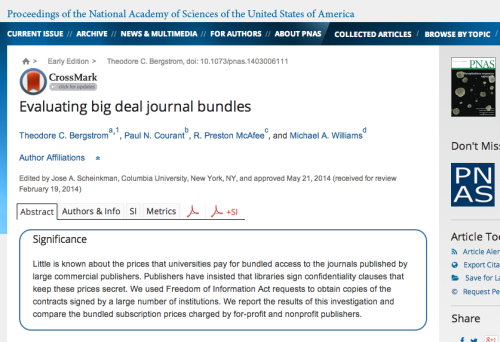We’ve all suspected it. We’ve all talked about it. Some have even written and spoken at conferences about it. But now we have hard evidence that there is incredible variation in terms of the amounts libraries are paying for the same content and that the variation doesn’t come close to relating to FTE or the number of PhDs graduated.
In the latest issue of the Proceedings of the National Academy of Sciences is an article, “Evaluating big deal journal bundles,” that shows us what many institutions are paying for journal packages and the crazy inequality of it all. The authors of the study got ahold of “big deal” contracts with publishers (non-profit and for-profit alike) from 55 public university libraries and 12 consortia via FOIA requests or just plain asking nicely. The article looks at cost-effectiveness in terms of cost per citation (basically journal prestige), which show that, based on that metric, non-profit journals are a much better deal than for-profit publisher bundles (and Taylor & Francis is a trainwreck in this regard). I didn’t find the metric they used particularly moving, but what is really interesting is what the data shows in terms of how some universities are getting much better deals than others. The authors found that —
the contracts we have seen show remarkable institution-specific price variation that cannot be explained by university characteristics such as enrollment and PhD production. Some institutions have been quite successful in bargaining for lower prices wheras others may not have been aware that better bargains can be reached. Perhaps this variation explains publishers’ desire to keep contract terms confidential.
While there is a paywall on the article itself if you don’t have a subscription, there doesn’t seem to be one on the supplemental data, which is what I think librarians will find most interesting. You can also read about the study at The Guardian and Science.
We know lots of things figure into the price libraries pay, membership in a consortium being a big one. I know we can stretch our dollars a lot further because we’re a member of the Orbis Cascade Alliance. But apparently, even then, others are getting better deals for whatever reason. the University of Oregon, part of our consortium, is pretty similar in size and numbers of PhDs graduated each year to Oklahoma State University. Yet OK State paid $185,795 for the Wiley journal package and the University of Oregon paid $285,036. So even being part of a large and powerful consortium doesn’t guarantee the best price. What does? Amazing negotiation skills? Being best buddies with your rep? Clearly, some librarians are negotiating some amazing deals for their libraries and some are not.
Do the prices have anything to do with ability to pay? It would be interesting to look at the prices from this study as a % of a library’s total acquisitions budget. Is there any correlation? We certainly know that some university libraries with large FTEs have very small acquisitions budgets relative to similarly-sized institutions (my own school — at 30,000 FTE — being a case in point). Does the University of Michigan pay almost twice as much as the University of Wisconsin for the same Elsevier package because their acquisitions budget is almost double the size? It’s possible, but I don’t know. While I’d like to think that publishers are sensitive to the budgetary limitations, but I have a bad feeling we wouldn’t see the hoped for correlation in every case. Some enterprising soul could easily do the math on this using ARL data and data from this study.
Now, I’m not involved in negotiating packages, but, as a subject librarian who has had to make cuts that impact our faculty members’ and students’ ability to do research, I find all of this pretty galling, especially when one looks at the profit margins of companies like Elsevier, Springer, and Wiley (all well over 30%). For those of you who have been involved in negotiating “big deals,” what do you think about the study’s findings? And what can we now do with this information? Now that we know on average how much other Research 1 institutions paid for x package (even ones of comparable size), can we use that as a negotiation tool? What can we learn from institutions that have gotten better deals?


Meredith, a lot of the variation can be explained by the amount historically spent on subscriptions. If a school had a lot of print subscriptions before entering into the big deal their bill would be higher than a school that didn’t have many. One of those articles uses the example of the U Wisconsin as an example of that.
There are other quirks too. Like if you had a not great negotiation one time your price will stay high since big deal prices never go down (or at least almost never).
You rightly mention consortial discounts which would certainly account for some of the difference. However, even within consortia the historical spend can leave similar schools paying radically different prices. It all depends on the publisher…
I second that – publishers are obsessed with your historical spend – what you spent in the print era. You are never allowed to go below that! So if you had multiple print subs for multiple campus libraries, particularly if they are science/medicine, you are stuffed forever.
I think a fundamental problem can be summed up in your post title; “Is YOUR big deal a good deal”. I’m going to say the answer to that is a flat no, across the board. What that data tells me is that pricing is utterly absurd and nonsensical and works for vendors because we allow it. If the model is that publishers have a margin they want to protect, which they do by dividing and conquering, then patting ourselves on the back because we fought for a 2% reduction on one product only to “lose” with the same negotiation tactics on another tells me that tweaks to our negotiating style aren’t what’s needed. We should be using this study as a call to arms that our current tactics simply do not work.
If we want to become better negotiators, we need meaningful collective action that isn’t working towards the best deal, but a good one, which in many cases may be no deal at all.
Pie in the sky? Possibly. But here’s a first step. Everyone – all libraries, all consortia, all over the world – stop signing non-disclosure agreements. Be Cornell: http://www.library.cornell.edu/aboutus/nondisclosure. Start with consortia working through an organization like ICOLC. NDCs aren’t a “necessary evil”; they’re unnecessary, damaging, and irresponsible, particularly in the public sector.
Our Elsevier contract is up for renewal this year, so I’m using data from this study (and additional data from sources identified in the study) along with some data obtained here https://www.aamc.org/data/ and at ARL to do some number crunching. It’s a small set, because I am only comparing institutions that also have a medical school, but so far the results (I’ve not yet accounted for budget info from ARL) are quite interesting. I know from talking with our rep that the cost of our package is a significantly higher percent of our budget than is average (average is 19-25%), and that is definitely borne out by my calculations (we pay quite a lot more than would be expected by looking at comparable institutions).
First — I’d like to know where I can go to find out what is Elsevier’s profit margin?
I am involved with the I2NY group — an initiative of the NY3Rs (regional library councils). The general goal of I2NY is “to do more with more” — or, in other words, to leverage resources of all kinds so libraries of all kinds in NYS can more (cost and otherwise) efficiently provide access to more resources to more patrons. One of the Task Groups in my Work Group wrote up a very interesting Industry Analysis Report with advice on what kinds of financial information you can find on what kinds of content providers and how you can use that info to get closer to learning about their profit margins. You can see the document on the I2NY website here: http://www.ny3rs.org/i2ny/databases/industry-analysis-report-by-i2ny-e-resources-task-group/
We also drafted a Licensing Manifesto, available to be endorsed here: http://www.ny3rs.org/i2ny/databases/i2ny-e-resources-licensing-manifesto/ The very first item is calling for libraries to strive to not sign licenses that have confidentiality clauses – because there is no doubt that the only purpose of such clauses is to allow providers to perpetuate such inequality in pricing.
It was interestiing to see that of the 5 Task Groups in my Work Group, three are working on “transparency in pricing” from one angle or another. Clearly this is an issue of great concern to libraries. I am looking forward to seeing the final results of everyone’s work.
But meantime, seriously — where did you find accurate info on Elseier’s profit margin? I am SO curious….
Hi Karin! I found it in an article, but doing a Google Search pulls up additional articles that cite Elsevier’s scholarly publishing profits being 39% for 2013. They also have an annual report that shares such info. http://www.reedelsevier.com/investorcentre/reports%202007/Documents/2013/reed_elsevier_ar_2013.pdf.
I really admire groups that are working to create more transparency in our dealings with vendors. It’s great to see leadership in this area!
[…] Is your big deal a good deal? by Meredith […]